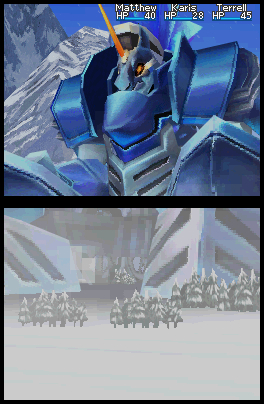Taking everything great about the series and updating it for play on DS
The game ends on a huge cliffhanger, random battles
Looking back, my E3 preview of Golden Sun: Dark Dawn was definitely mixed. Thankfully, this is one of those times that being able to play the final version of the game gives a completely different experience and a much more favorable opinion of the game. Golden Sun: Dark Dawn is a perfect example of Nintendo innovating a series the right way, and if you even mildly liked Camelot’s original entries in this RPG series, then this game must be on your list.
Dark Dawn picks up 30 years after the events of Golden Sun and Golden Sun: The Lost Age. Instead of playing as silent protagonists Isaac or Felix, players will take on the role of Matthew, Isaac’s son. In fact, the first four adepts in your party are all children of the famed “Warriors of Vale” who were responsible for the Golden Sun rising over all of Weyard. The story is entirely approachable for those who haven’t experienced the first two games thanks to an encyclopedia feature which underlines important names and can be clicked on to give a short summary, and which will update with new information as the journey continues.
 The story itself is quite epic, though the “Psynergy Vortexes” that were much featured early on in the trailers for the game are not really focused on, being forgotten entirely an hour into the gameplay. Yet Dark Dawn does a great job of expanding the world of Weyard, giving ample information about the history and ancient peoples of the world. It really does a great job of expanding the interesting stories of its predecessors into a much more epic scope.
The story itself is quite epic, though the “Psynergy Vortexes” that were much featured early on in the trailers for the game are not really focused on, being forgotten entirely an hour into the gameplay. Yet Dark Dawn does a great job of expanding the world of Weyard, giving ample information about the history and ancient peoples of the world. It really does a great job of expanding the interesting stories of its predecessors into a much more epic scope.
And as the story definitely got an upgrade, so did the gameplay. On the field control level, the camera is less restrictive of how players use Psynergy. Any time you go to use a form of Psynergy, a circle is highlighted around the character, showing how close items have to be before you can affect them. The game utilizes the touchscreen masterfully, letting you tap to select an item and swipe directionally to move items or direct the Psynergy selected. But if you hate the touchscreen altogether, the entire game may be played without using it. While a certain level of precision may be missing from not using the touchscreen, it’s nice to see that Camelot accommodate older players who are accustomed to the old control style. Sadly, the game still uses the tried-and-true JRPG method of random encounters with monsters. It’s a shame that a Dragon Quest IX approach could not have been taken.
 The battles, however, have been streamlined. The touchscreen controls are kept to a minimum, being used for menu selection. Standard controls can also be used just as in the Game Boy Advance iterations of the series. One major upgrade to the game is the fact that characters will attack another monster if their target has been killed in battle. Now, you can just tap the A button to get through the various random encounters, without having to meticulously plan every turn so that you’re getting the most damage possible instead of having your characters defend if their targeted monster is gone.
The battles, however, have been streamlined. The touchscreen controls are kept to a minimum, being used for menu selection. Standard controls can also be used just as in the Game Boy Advance iterations of the series. One major upgrade to the game is the fact that characters will attack another monster if their target has been killed in battle. Now, you can just tap the A button to get through the various random encounters, without having to meticulously plan every turn so that you’re getting the most damage possible instead of having your characters defend if their targeted monster is gone.
Another major addition to Dark Dawn is that the unleash system has been overhauled. Every weapon in the game has at least one unleash (or critical) attack, and several have two or even three. They are graphically pleasing when they occur, as well as doling out extra damage. Certain unleashes also have the benefit of attacking monsters next to the target, something that previous games did not feature. Not all unleashes are immediately available, as the game has a minor weapon experience system where using weapons gives the character experience with that weapon until they’ve mastered the use of it. Weapon mastery, as well as unlocking advanced unleashes, makes unleashes more likely to occur.
 The Djinn system also makes its return in Dark Dawn, and it is one of the few mechanics that has seen no changes. In fact, the list of summons obtainable in the game is almost identical to The Lost Age, which is sad as all summons have been upgraded to take advantage of the dual screens in breathtaking cinematic sequences. All in all, 72 Djinn may be obtained in the game through various methods. The game does have a few Djinn that feature brand new effects, but the majority of the new Djinn available in the game do variations on effects of Djinn found previously in the series.
The Djinn system also makes its return in Dark Dawn, and it is one of the few mechanics that has seen no changes. In fact, the list of summons obtainable in the game is almost identical to The Lost Age, which is sad as all summons have been upgraded to take advantage of the dual screens in breathtaking cinematic sequences. All in all, 72 Djinn may be obtained in the game through various methods. The game does have a few Djinn that feature brand new effects, but the majority of the new Djinn available in the game do variations on effects of Djinn found previously in the series.
There is also a problem with many of the Djinn being able to be lost forever. The story features various roadblocks in which players are forced to never return to where they’ve been. When this happens, any Djinn that has not been met is lost forever, and there is no way to recover it by the end of the game. It’s really a shame, as completionists will most likely need to play the game with a guide or FAQ at hand in order to avoid this problem.
The game’s art style is impressive at points, though the chibi style of the main characters returns for any overworld journeying. The battle scenes, on the other hand, appear to have been updated to fully take advantage of the system’s graphical capabilities. The music is, once again, fantastic, featuring variations on themes already established in earlier games, while incorporating new material of its own.
Golden Sun: Dark Dawn is a fantastic return to a series that has been dormant for seven years. The sequel takes everything loved about the original games and updates it for new hardware. That said, it will be interesting to see how the series continues to grow with 3DS on the horizon and a big cliffhanger after the credits roll. Really, the only reason to miss this game is if you hate JRPGs, because otherwise it’s a must-buy.
Nintendojo was provided a copy of this game for review by a third party, though that does not affect our recommendation. For every review, Nintendojo uses a standard criteria.




 ShareThis
ShareThis






Really? I got like 1/2 way through it and lost interest. The puzzles and gameplay is fun but the story and characters are bland they talk way to much.
I still need to get this. I never played The Lost Age, but I loved the first Golden Sun, so it’s reassuring to see such a positive review. Maybe I’ll use some of that excess Christmas money I have. XD